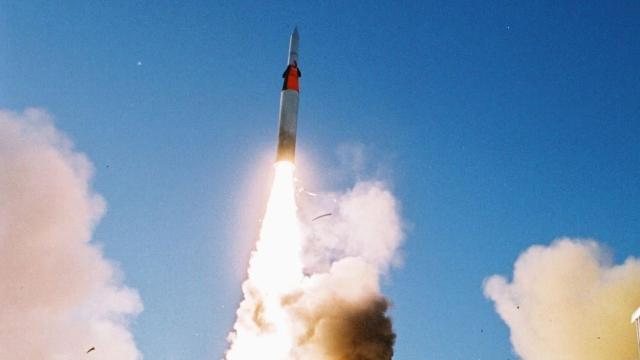Early last week, Israel’s Arrow 2 missile system successfully intercepted and destroyed a suborbital ballistic missile suspected of launching from Yemen. It’s a notable technological achievement, but one with potentially serious legal and geopolitical implications.
The Israeli Defense Force (IDF) shot down an Iranian-manufactured ballistic missile using its Arrow 2 anti-missile system, Haaretz reported. The incident happened on Tuesday, October 31, with Yemeni forces possibly targeting Eilat, an Israeli city on the coast of the Red Sea. The Telegraph claims the missile was intercepted and destroyed above the Kármán line, which at 62 miles (100 kilometres) above sea level is widely recognized as the boundary of space.
There have been many earlier instances of missile-on-missile interceptions above the Kármán, according to Harvard-Smithsonian astronomer Jonathan McDowell. However, all previous cases involved interceptors targeting missiles launched by the same party for testing purposes, whereas this is the first occurrence of a missile successfully intercepting an incoming missile from an adversary in space, McDowell, an expert on space launches, explained to Gizmodo over email.
Ballistic missile defence systems generally engage threats within the Earth’s atmosphere. While anti-satellite tests have demonstrated higher-altitude capabilities, such as those conducted by the U.S., Russia, China, and India, these have been distinct from intercepting a missile in flight.
“There is currently insufficient information available to verify [this] situation,” Tomas Hrozensky, a senior research fellow at the European Space Policy Institute, explained to Gizmodo in an email. That said, mid-range ballistic missiles can fly at heights well above 62 miles, and the “Arrow system is considered as a de-facto counterspace capability due to its nature of high-altitude interceptions,” he added.
Yemen’s Houthi rebels claimed responsibility for the attack. Since 2015, Houthi forces have extensively utilized missiles and drones supplied by Iran in their ongoing conflict with an Arab coalition. Israel declared war against Hamas after the Palestinian militant group launched cross-border raids from Gaza on October 7, prompting a pro-Palestinian response from the Houthi rebels.
Haaretz reports that the destroyed missile was a Qadar, an enhanced version of Iran’s Shahab 3 missile, and it says that the incident represents the farthest range attack attempted by the Houthis to date at an estimated 994 miles (1,600 kilometres), but the exact launch point is not yet known. The incident is possibly “the first combat ever to take place in space,” as The Telegraph reports.
The Arrow 2 system, operated by the IDF and designed specifically to intercept ballistic missiles, is distinguished from other missile defence systems by its capability to engage targets at high altitudes and—as now proven—in space. A ballistic missile, such as the one launched by the Houthis, typically follows a suborbital trajectory to deliver one or more warheads to a predetermined area. This technology traces back to the V-2 rocket developed by the Nazis, the first-ever ballistic missile used in warfare.
The history of Israel’s Arrow system dates back to the 1991 Gulf War when Israeli cities faced the threat of Iraqi Scud missiles, which overcame U.S.-supplied Patriot interceptors. This led the IDF to establish the Homa (“Fortification”) Organization, aimed at creating an effective missile defence system for the nation. Israel previously deployed the Arrow system in 2017, intercepting a stray Syrian S-200 missile with its Arrow 2, averting potential civilian casualties, according to Haaretz. The incident from last week marks the system’s “first operational intercept of a ballistic missile,” according to Breaking Defence.
The Outer Space Treaty (OST), formally known as the Treaty on Principles Governing the Activities of States in the Exploration and Use of Outer Space, including the Moon and Other Celestial Bodies, prohibits the placement of nuclear weapons or other weapons of mass destruction in orbit around Earth, on celestial bodies, or stationing them in outer space. It does not explicitly forbid conventional weapons, nor does it address the interception of missiles in space. Accordingly, the destruction of a conventional ballistic missile by the Arrow system—even if it occurs above the Kármán line—does not appear to breach the OST. McDowell agrees, saying: “As far as I know it does not really violate any treaties.”
Importantly, there’s also Article 3 of the OST to consider, which states that parties to the treaty shall act “in accordance with international law, including the Charter of the United Nations,” which, in its Article 51, provides for the right of self-defence.
The ballistic missile very likely did not come anywhere close to Earth orbit, so unlike those aforementioned anti-satellite tests, this incident probably didn’t generate any dangerous orbital debris. Indeed, “implications on space safety will primarily depend on the altitude of interception,” said Hrozensky. “The occurrence and increase of interceptions especially at higher altitudes (e.g. reached by ICBMs) would most definitely have negative and concerning effects on the safety and sustainability of the space environment,” he explained.
This incident demonstrates not just an advancement in Israel’s defensive technology—it establishes a new paradigm in strategic military considerations. Nations around the world might have to reassess their offensive and defensive capabilities in light of this development, potentially affecting international security and arms control discourse.
